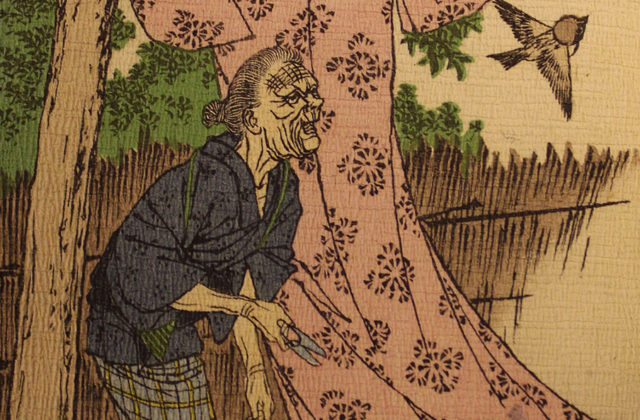Japanese Crepe-Paper Books in the Norfolk Library
Treasures from the Rare Book Room
By Lucy Mookerjee
“The Tongue Cut Sparrow” is a Japanese fable about an old woman who cuts out the tongue of a sparrow for stealing her washing basket. When her neighbors rescue the sparrow, the basket is returned to them filled with jewels. Hearing this, the old woman sets out to find the sparrow herself. The sparrow offers her the choice between two baskets, and she chooses the heavier, thinking it will contain greater treasure. Hastily tearing off its lid, she uncovers a seething nest of monsters; they devour her on the spot.
The Norfolk Library holds an early English translation of this cautionary tale. Published in Tokyo in 1884, the book is printed on Japanese crepe paper, which is made from pulp, heat dried and scraped with a blade, giving the pages the texture of fabric. The book is illustrated in full-page woodblocks, each delicately hand colored. The fairy tale is magical to hold and to behold. But its enchanting materiality masks an elusive history: how did this exotic item find its way to Norfolk?
The fable is part of a series of Japanese crepe-paper fairy tales that surfaced in Tokyo in the late 1800s. The tales were originally intended for Japanese students of English but became popular with Westerners at a time when English-speaking intellectuals (who arrived in Japan on the heels of a wave of missionaries) were initiating fresh exchanges between Japan and the outside world. One of these pundits was an American reporter for The New York Tribune, Edward House, who arrived in Japan in 1870 and founded The Tokyo Times, an English-language newspaper funded by the Japanese government. House’s circle of intimates included a professor at Tokyo Imperial University, Basil Hall Chamberlain. House and Chamberlain were compiling the first English guide to Japan when the Japanese publisher Takejiro Hasegawa hired Chamberlain to translate “The Tongue Cut Sparrow” into English. House’s comrade went on to translate many more Japanese fables for Hasegawa.
Years before The Tribune sent House to Japan, the paper had assigned him to cover the 1859 execution of John Brown, the fiery abolitionist responsible for the raid at Harpers Ferry. House’s version of the events at the execution included the decisive detail of a kiss that Brown allegedly gave an enslaved child. House’s rendition of the scene was almost certainly fictional, yet it inspired several works of art over the next quarter century, among them a painting by Thomas Hovenden, commissioned by Norfolk’s Robbins Battell. In truth, House was not present at Brown’s execution. When a California newspaper declared the story false, Battell sent his secretary, Carl Stoeckel, to Hartford to interview the now-ailing House about the circumstances that had inspired Hovenden’s painting. Over the course of three days, House confessed that he had made up the story. Stoeckel recorded the confession in a 13-page letter, which he never sent, though it is widely believed Battell was its intended recipient.
That same year, House’s first and only novella, “Yone Santo,” appeared in The Atlantic Monthly. “Yone Santo” is a fairy tale following the Cinderella tradition. Its heroine is an orphan whose precocious nature captures the fancy of a handsome, enlightened Westerner, who directs her education, shielding her from the overzealous women missionaries in her hometown.
In speculating about the itinerary of “The Tongue Cut Sparrow,” it’s important to remember that House and Chamberlain inhabited a Japan in transition. Championing the end of a propagandist missionary era, they made it their mission to tell the story of a “true” Japan. One narrative that might explain the fable’s home in Norfolk is that House pocketed the book—an “authentic,” non-Christian representation of folkloric Japan—and presented it to Stoeckel during the Hartford meeting. Returning from his sojourn, Stoeckel might, in turn, have presented it to Battell as an exotic fairy tale from the East, which, much like the old woman’s chosen basket, carried House’s concealed condemnation of a seething “nest” of missionary “monsters.”

